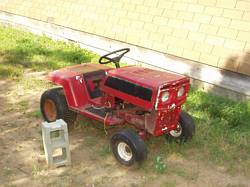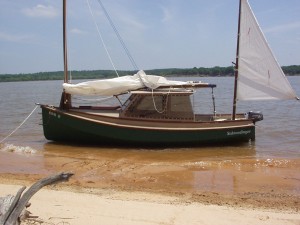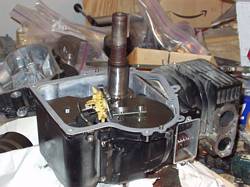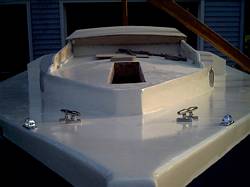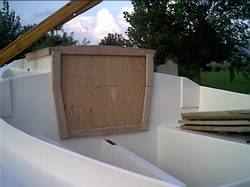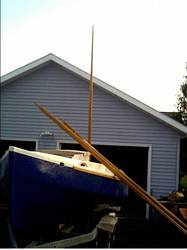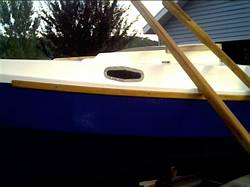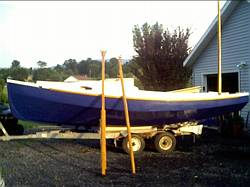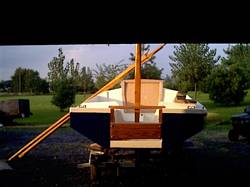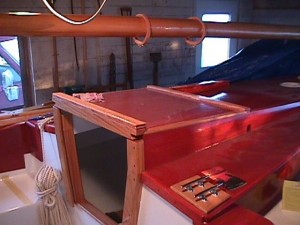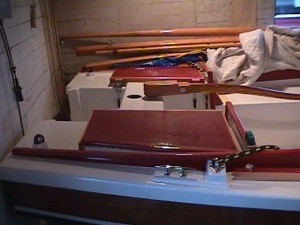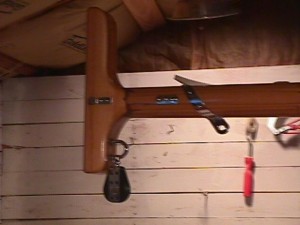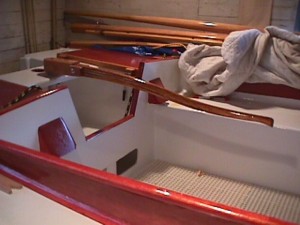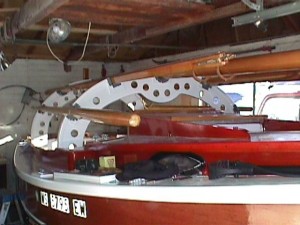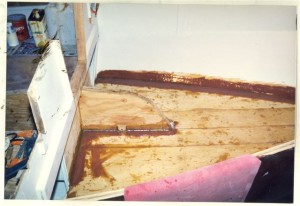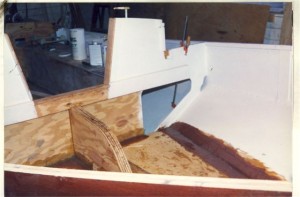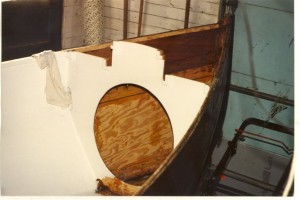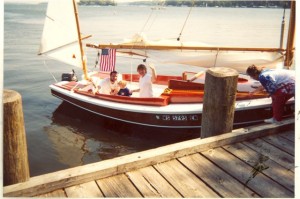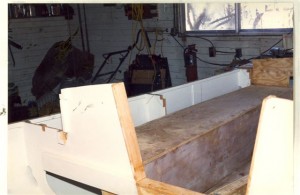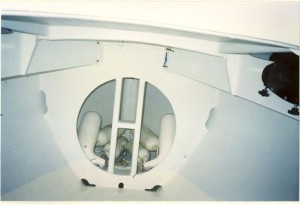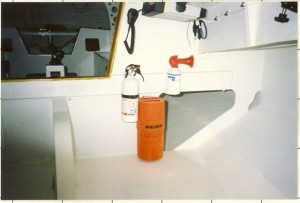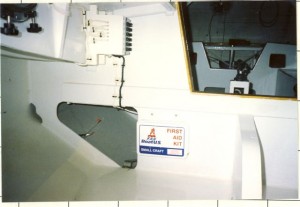News, questions, and boats for sale.
News:
| Good morning Richard,
How are things going down in Oklahoma? I have attached a URL that describes the building of “Two Grumpy Old Men” http://www.adventurequest-usa.com/New_Folder/chebacco.htm All the best, Mike Haskell, Founder/CEO |
Questions:
|
I have a question that I have been pondering and was wondering if some of your readers could answer, specifically, what are the possibilities of coastal cruising the Chebacco or maybe island hopping in the Keys or Carib?
Thanks,
|
| Hi Richard,
I’d love to have one or more Chebaccos sail into the Sept. Messabout in Kingston, perhaps yours. Would you post the invitation in your Chebacco Newsletter for me? If so, please post the link to http://www.brucesboats.com as the Messabout figures prominently on the home pages with links to three pages on the event, and multiple pages about the area, navigation, the campground, etc. Do you know who bought Bob Cushing’s Chebacco Motorsailor? I saw that once, it’s a very nice arrangement. So is the new cruising conversion. Hope to see you and lots of other Chebacco drivers there. Bruce Hector |
Chebacco’s for sale:
| Samantha is for sale.
Details: 20 foot sheet plywood Chebacco. Built summer of 2002. Sailed from Portland, ME to Beaufort, NC and back since. This boat is a modified Chebacco – it varies from the design in the following ways: It has a shallow draft keel rather than a centerboard, the cabin is longer, wider and taller allowing a full length double berth and facing settees with a fold-down table. The cockpit is shorter by the amount the cabin is longer. She is gaff- The following equipment is included: Standard Horizon VHF radio, 80 AH deep-cycle battery, 6 hp Tohatsu 4-stroke outboard with alternator, navigation, anchor and cabin lights, 2 anchors with rodes, dock lines and fenders, Ritchey compass, 2 type III and 2 type V PFD,s, safety harness, ABC fire extinguisher, flare kit, and Nymph She is located in Portland, ME at present and I could possibly deliver her – that would be negotiable. This has been a very nice boat, but like many of us boatbuilding sailors I want to build another boat (probably some variation of Newfoundlander). I am not sure what to ask for this boat. The bare boat may be worth $4000 and the equipment listed above is about $2500 new – plus the dinghy. How about $5500 for the whole package? Make an offer – nothing can offend me – the worst that can happen is I would say yes. Paul Thober, 207 712 0381, leave a message and I will call you back. |
| Hi Richard, My Chebacco Motorsailer is for sale -It was shown in Chebacco news # 17 and 25 , built in 1997 and has had very little use so it looks like new and is available with or without motor and trailer. Price for boat alone is 7500.00 Thanks, Bob Cushing rbrtbobcat@aol.com 315-687-6776 located in Cazenovia, n.y. |
| How’s it going? I wanted to let folks know about my decision to sell my Chebacco. I really love this Catboat but I love my girlfriend more and want to pursue that a while. The boat is built exactly to Phil’s Specs. The trailer was purchased new for $1,300 a couple of years ago and the 1997 Force five hp. Outboard was purchased new for $800 as well (it sat on the showroom a long time I guess). The sails were purchased as a kit from sail-rite, the mainsail being sewn by a professional, and the mizzen sewn by me since it was small and manageable. I launched this boat for the first time in April of this year and have taken one two week trip and several small day trips so far. There are a few normal scratches on the hull and the spars but nothing out of the ordinary. The hull is planked in Douglas Fir Marine plywood and the floors and roof framing are Douglas Fir. There are a couple of floors made of Southern Yellow Pine and the trim is all White and Red Oak. The sliding hatch was cold molded and then veneered on the inside and out with White Oak as were the drop boards – no sign of wear on any of these components. All trim and spar varnish was Epifanes WoodFinish Gloss and it shows.
Bill Samson listed his for 4,500 lbs. Sterling which is approximately $6,500 I think. I would like to ask $6,500 to start and see what happens. Thanks Richard. Pete Respess |
| Lapstrake Chebacco 20
LOD: 19′ 6″ Built by an experienced amateur. Over four thousand hours building time. The best of materials used. Finished with two-part polyurethane. Sprayed by a professional. Bright work finished with Norwegian varnishing oil (between six and eight coats). Hull is built of 7 ply half-inch marine mahogany plywood; keel is built of same material, laminated to proper thickness.The keel is covered with double thickness of 11 oz. fibreglass cloth saturated with epoxy. 1/16 inch stainless steel was then attached to the bottom of the keel and up the stem as far as 22 inches above the waterline. Outside of boat is covered with 11 or 6 oz. fiberglass cloth which was then saturated with epoxy, then an additional four to five coats to allow for sanding to a mirror finish before painting. Inside has four coats of epoxy. Spars are solid sitka spruce. Fittings are all top quality such as Harken or custom made of bronze or stainless steel. Three sails (main, jib, and mizzen.) All lines, sheets and halyards ready to go. None of them ever used. Custom made trailer with extendable tongue for easy launching. Elaborate supports that fit to cabin and aft cockpit bulkhead to hold spars for long distance trailering. No O.B. motor. (4 to 5 HP would be suitable.) The boat was completed Sept.2000 but ill health precluded launching and am selling the boat now for the same reason. Price $12,500 USD (See article in Wooden Boat – #107, Pg. 80) Address: Email: gcobb@nbnet.nb.ca |
***
Toothless gears and the Zen of boat building.
One day I took a transmission apart and fixed it.
That really doesn’t describe what happened, lets try that again.
One Saturday afternoon I decided to fix up the old riding lawn mower a friend had given me.
This was a freebee, kind of a long-term project, no chance I would get it fixed in time to use it for mowing this year. At the time I was still intimidated by the engine, so I decided to start on the transmission. I was intimidated by the transmission too, but not nearly as much.
The temperature was just on the high side of warm, but the porch I was using as a table was in the shade and there was a gentle breeze blowing.
I start taking the transaxle off, bagging each part in Ziploc, taking my time, using wrenches instead of a socket and ratchet. I’m in no hurry, I have all afternoon to do this, and have no other pending plans.
There’s a young woman in the house watching TV. All is right with the world.
I put the transaxle in an old washtub, and fill it about half full of gasoline through one of the drain holes. After a little sloshing around, I drain the oil and gas into the washtub, to go into the barrel for eventual recycling, or use with an oil burner on the foundry furnace, I haven’t decided yet.
As I carefully and methodically pull apart this device I know nothing about, cleaning each part off before bagging it, I notice the birds are singing in the trees.
As I get it apart, I discover the reason it isn’t working. Three of the gears in the thing are missing teeth. The main drive gear is completely toothless. Ah, that would cause it not to work.
I finish taking it apart, and bag all the pieces.
Later that evening, I have a flash of brilliance, (hey, it happens occasionally), I Google “lawn mower parts”, and send an email asking for help identifying the transaxle to the top twelve hits. This is a saturday, but I get an immediate response from two of the victims.
One of these respondents had rebuilt “hundreds” of this exact model transmission, tells me what to check, what the rules of thumb are, which parts need replacing, what I can get away with not fixing, how to check this, that, and the other thing. I buy all my parts from him.
A very enjoyable day. Almost like building a boat.
To misquote Zen, or Ben, or someone, or at least the Kung Fu master from an old western. “Revelation starts with the simple statement, ‘I don’t understand.'”So, that is the toothless gears part. Where does Zen, and boat building come in?
So, I find myself, now and again, working on something I have never worked on before, muttering the infamous words “I don’t understand.”
Then I poke at it and ponder over it till I *DO* understand. The light dawns. How simple!
What I like about building a boat is the problems. Not that I like all problems, mind you. For instance, the solution to the problem “How to get this pretty young woman to fall in love with me?” has always eluded me, and I suspect it always will. No, the problems I like are of the solvable, engineering kind. “How do I build a 20 foot tall mast out of 8 ft long boards?”, or “How do I sand this hull smooth without ending up in the hospital with back problems?”.
As with toothless gears and lawn mowers, the real joy of boat building comes from learning to do something you never thought you could do, that you have always been intimidated by.
I’ve built six boats, from disposable (which lasted 5 years before I gave them away) pirogue canoes, to 20 ft cabin cruisers. I’ve solved most of the engineering problems with building a boat. You know the ones, “How the hell am I going to get it out the door?”, and “How do you flip this huge thing over?”, as well as the construction problems, like “How do you make a round mast out of square
boards?”, etc.
I have moved on to machinery and small engines, which I have always had issues with.
Have I given up boat building, has it lost it’s challenge? No, not really. Lets just say I have graduated to the next level. I am having visions of Caspian Sea Monsters and Wings in Ground Effect…
And, now that I have overcome my engine anxiety…
Laters, Chebacco Richard
***
Depoe Bay 2003 – Jamie Orr
The 2003 Depoe Bay Crab Feed and Wooden Boat Show took place on the last weekend of April. And a fine show it was!
Once again, Dad and I drove down to Oregon, pulling Wayward Lass behind us. We started Thursday morning, catching the ferry from Vancouver Island then crossing the border at Blaine, Washington. We stopped there at the Canadian customs office to have them stamp a picture of Wayward Lass, so we wouldn’t have any problems coming home. Boats with motors under 10 horsepower don’t have to be licensed in Canada, so Wayward Lass has no numbers – this caused a delay in 2002 when the customs agent thought we were boat smugglers and we almost missed the last ferry home!
Our first stop was Seattle, to visit Chuck Merrell. We met Chuck in 2000 at the informal Bolger boaters gathering at Port Townsend’s Wooden Boat Festival, and have kept in touch since. We pulled off the freeway near Boeing Field, and followed Chuck’s directions to South Park Marina on the Duwamish Waterway, where he lives and is building Ace, one of his own “barrel boat bachelor pad” designs. If you’re not familiar with Chuck’s website, go to http://www.boatdesign.com/ for his designs, his Bolger Micro page and other good stuff.
We caught up on the latest news over dinner, and inspected Ace, which is almost finished and looks like a snug home for Chuck, and Dumpster the cat. Ace will be moored at South Park marina once she’s launched. We considered spending the night in Seattle, so we could park the boat and trailer safely in the marina yard, but the thought of the morning rush-hour traffic changed our minds. Instead, Dad and I drove for another hour, stopping just outside Olympia, the state capitol.
Next morning we reached the Columbia River at Portland just after 9:00. Once across, we abandoned the interstate for the back roads, moving in a more or less south-westerly route through McMinnville to Lincoln City on the coast, just a few miles north of Depoe Bay. This isn’t the fastest route with all its small towns and winding roads, but it made for an interesting morning. We stopped for lunch in Lincoln City. Dad had an excellent “Scottish soup with pieces of lamb”, (where I grew up it was called Scotch broth – is this the latest effect of political correctness?) I had flatbread, with melted cheese and thinly sliced sausage that left my taste buds tingling. The Blackfish Café — good place to stop, if you’re passing by!
We arrived at Depoe Bay about 1:30, and after a leisurely rigging-up, Wayward Lass slid into Oregon waters again ,and was left in the first empty berth while we took a look around. We found that we were among the first exhibitors to arrive, but it didn’t take long before we saw a few familiar faces, and boats, including John Kohnen (Pickle), Terry Lesh (Toto) and John Ewing (Surf and Jon Junior).
By then we were thinking of our stomachs, so we arranged to meet at the Spouting Horn for dinner, and went along to our motel, the Troller’s Lodge, to check in before walking down to the ‘Horn for an evening of good food and better company.
I woke early the next morning, and couldn’t get back to sleep, so just after 6:00 I was down at the boat, pumping out the rainwater. Between the trip down, and the rain overnight, the floorboards were floating. Since it was still pretty wet outside, I wasn’t a fanatic about pumping, no mopping up the last drops! The Coast Guard were awake, too, taking their 47 footer out into the bay. I heard them come in again after a short time, so maybe it was just a training run.
Back to the Troller’s for a shower, then over to the Whale Watchers Café for breakfast. Larry Barker joined us here, the three of us had plans to go “outside” for a sail after. The Coast Guard was allowing boats over 16 feet to go in and out, the lowest restriction we’d seen, to date.
By the time we reached the harbour, the sea wall was alive with boats and boaters. Depoe Bay is largely a dry land show, with most of the exhibits displayed on the sea wall overlooking the docks, but this year there were quite a few boats in the water as well. Pat Patteson presented me with my Western Oregon Messabout Society burgee, with its coot emblem. I’m not sure if the group chose that emblem deliberately, but it fits pretty well, so now Dad and I are officially “old coots”! We took a few minutes to get the burgee hoisted, then and Dad, Larry and I fired up Honda and took Wayward Lass out of the harbour.
You have to remember that this is the third year we’ve been here, but the first opportunity we’ve had to get out on the ocean. Depoe Bay doesn’t have a bad bar, as such, but the entrance to the harbour is a narrow dog-leg where the Pacific swell often makes getting in and out problematic, so we used the outboard generously to make sure the waves didn’t push us around. Once out and clear, we put up the sails, and shut down the motor.
You should also know that there are some nasty reefs on either side of the bay, where the swell piles up and breaks. We were fully aware of these, so didn’t stray from the safe line between the entrance and the bell buoy that marks the transition to open waters. The swell was of a size I hadn’t experienced before, we were moving up and down some 10 feet every 13 seconds. I have to say that I was somewhat intimidated by the combination of the swell and the lurking reefs (we didn’t have a chart). This, on top of the horror stories we’d had fed to us over the last two shows made the old pulse run a bit faster than usual. The boat, however, was perfectly at home!
We sailed out to the bell buoy on a close reach, the wind being pretty much from the southwest. We noticed the swell was more regular and not so steep once we were past the bell buoy, which marks the end of the shallow area, more or less. Once we tacked, the course back to the entrance was an easy reach, so we took advantage of that and headed in again – not very adventurous, I agree, but okay for a maiden voyage. Being still very aware of the reefs, we turned into the wind to start the motor while still fairly far out. Of course, the motor chose this opportunity to be awkward, taking half a dozen pulls to start. I’ve noticed this before, that it’s slow to restart when it’s cooling down. When fully warmed, or cool, it only takes one pull – maybe two on a bad day.
But it did start, so the sails came down and we motored back along that line between the bell buoy and the entrance. Larry watched the back bearing while I watched the entrance – we didn’t always agree on the right heading, but the differences were small enough. At the entrance it’s best to go in on the back of a wave, to avoid surfing, but with only five horses, it takes more practice than I’ve had. There wasn’t any danger anyway – I don’t know where the swells went, but by the time they reached the entrance, the waves were small. Honda pushed us easily through the dog-leg and we were back in the harbour.
Once we were tied up again, it was time to have a proper look at all the other boats, not to mention picking up our free coffee and doughnuts (just for bringing a boat along!) There were all kinds of good boats – a lot of great canoes and sea kayaks, in stitch and glue, cedar strip, and even some wood and canvas beauties. The wood and canvas folks demonstrated how to steam bend white cedar ribs – made it look as easy as anything. They also bent some oak stems later with less success, I saw the remains and it looked like they’d been defeated by bad grain in the oak.
Besides the paddling boats, some of my favourites were the Bolger light dories (of course), the 19 foot Bartender, Pat’s PK 20, a rebuilt 1948 Guernsey Falcon and a new dinghy, both lapstrake and built, or rebuilt, by the same exhibitor. Dan Pence stole the show, though, with his just-finished Light Schooner. He started by yuloh-ing over from the launch ramp, then dazzled us all sailing around the harbour. The Light Schooner seemed to accelerate instantly with every puff of wind, and fairly flew along – spinning around on that big dagger board so Dan (ably assisted by his wife) never even hit the dock once! An incredible boat indeed!
Chuck Gottfried was there with Tabby, his strip built catboat – 17 feet, if I remember rightly. Chuck is currently building a Chebacco as well, so I must compliment him on his excellent taste in boats! Unfortunately the Chebacco wasn’t far enough along to bring to Depoe Bay, but should be there next year.
Harvey Golden brought a couple of traditional kayaks, one of them without the skin so we could see how it was lashed together, and he also demonstrated his incredible Eskimo rolling techniques again. Unfortunately I managed to miss most of this, but after the last time I ran out of superlatives anyway. Harvey has a great website too, I don’t have the URL but a google search will turn it up for you.
There were other good boats there too, more than I can remember – I’ve been wishing I’d taken some pictures, but fortunately John Kohnen was there with his new digital camera, taking hundreds. He’s posted a good selection at http://www.boat-links.com/DepoeBay/03/BoatFest-1.html, so go there to see them.
The weather was a bit unsettled on Saturday — one minute it would be bright sunshine, the next, rain would be pouring down, only to stop as suddenly. However, it didn’t seem to bother anyone much, and by early afternoon it had straightened itself out and stayed sunny the rest of the day. Which was good, because we were able to sit down in Wayward Lass for a while, and drink some of Chuck Gottfried’s beer. Chuck introduced his brother Roland, and a few others soon came by. In the end there were seven or eight of us in the cockpit, enjoying the good life!
Once we were all rested and refreshed, there was just time to check out one or two more boats before going up to Gracie’s B&B for the exhibitors’ reception, where they fed us finger food and a variety of Oregon wines. Actually, I only sampled the Cabernet, but it was excellent. A few exhibitors addressed the group, but the star turn was our hostess Gracie, who gave a great talk about Depoe Bay, the boat show, how good the food was at the Sea Hag, and sundry other local subjects. About 7:00, the B&B folks needed the room back for their paying guests, so the party moved to various restaurants, to consume more food and drink, and continue the Great Boat Debate.
Next morning was dry, and promised a fine, sunny day – not only that, but there were no restrictions in force for the harbour entrance! At all! This was a mixed blessing to us, because we had to be on the road before noon, and its always easier to leave when its raining. However, we looked forward to making the most of the morning.
Things semi-officially kicked off for the day with a lone bagpiper making sure no one overslept, then Dad and I went for another sail. Except for being sunny, I don’t think things were very much different, but we knew what to expect this time, and were able to enjoy. The wind was from the southeast, which meant it blew straight from the harbour mouth towards the buoys, giving us a good run out to the second buoy, that marks the 100 foot or 16 fathom (deep) line. There were several sea lions sunning themselves on this one, they pretty well ignored us as we sailed around them.
We had to beat back directly into the wind, which was fading fast (not the swell though, it carried on going up and down like an elevator). With the sun right behind the harbour, it was hard to pick out the bell buoy, but binoculars helped. After a couple of tacks we reached and passed it, but by then there the wind was so weak that it wasn’t worth trying to sail closer in, so we started the motor again – only one pull this time. We were fairly blasé about the entrance this time, but were surprised by the strength of the current flowing out with the ebb, just like a river.
We went straight to the launch ramp, and got Wayward Lass hauled out and packed up before going around to the sea wall again to say “so long” to the folks. It was hard to be leaving early on such a nice day, but needs must, and all that, so just after 11:30 we pulled out for home, arriving there some 492 miles and12 hours later.
A great weekend – many thanks to Jack Brown and all his fellow organizers! See you again next year.
***
A Sunday at the lake.
We pulled into “Bear’s Glen”, small park next to hw 64 bridge. Bit more drive than my usual launching place, worse launching conditions, but it get’s you almost to the bridge so you can sail different parts of the lake. Main reason to have a trailer sailer is to sail in different waters, as we are doing today.
There was a catamaran, probably a hobbie whatever, setting up in the only nice shaded spot, they had just got the mast up, two guys working on setting it up. “I’ll show them!”, me thinks. We pull up behind them, and with Brian and I working together we had the boat ready in 5 minutes, and pulled around them to launch. 30 minutes later we sail out of sight of the launch ramp, and they still hadn’t launched. Ah, the joys of a Bolger boat.
Tried teaching the boy to sail, and he did eventualy learn to keep the boat more or less going forward. Kind of like a snake goes forward. Though to tell the truth, it took me awhile to learn to hold a steady course in the puffy, unpredictable wind we have here in central Oklahoma, too.
Brian crashes below decks, and I set the boat up for self steering. The most memorable part doing 4 knots or so to windward, exactly parrallel to the shore, using both hands to put on sunscreen, watching the campers 100ft away on the shore. When trimmed right, the boat will adjust it’s coarse perfectly to the wind, head up in the puffs, fall off in the lulls. She sails OK in the light air we had, but Ze boat, Ze REALLY like’d ze wind.
Sailed up to the railroad bridge by Manford, probably about 10 miles, most of it beating to windward.
Ran back in force 3 winds. SWEET. Boat was trying to climb over the bow wave, was doing at least 7 mph. A 10 mile run back to the ramp, at least 20 other sailboats out by now. We are cooking along at just over hull speed, running wing and wing. Now, THIS is sailing!
Sailed up to the beach and had to answer the inevitable “What type of boat is that? Is is new, or old? You BUILT IT?”. At least this time it was a pretty girl asking the questions. I even tried to be friendly!
Yanked the boat out just as it was getting hot. Very nice day at the lake.
***
The Boat – David Lewis
So, this guy has a boat. Well, he WILL have a boat. Right now he’s got a bunch of boards and screws and glue and stuff.
So, he’s gonna build himself a boat. But instead he works on playing with the head of this strange female that’s living in his house. She’s strange – did I mention that? And he’s not sure how or why she came to be living in his house. He just knows she’s there and she’s annoying.
So, he’d be building this boat if he weren’t fighting with her or playing with her or studying her or otherwise wishing he could do more to her but knowing that that would just be too strange.
So, when he finally gets tired of her and gets rid of her then he’ll build this boat. And into it he will put all the strangeness he’s taken from her in his strange games. And people will look at his boat and wonder. Some will hate it, think it’s ugly, stupid and downright…bad maybe. Others will say “cool” and go elsewhere or just shrug their shoulders and turn away. Some few will stare at it for hours on end, wondering at the strangeness they feel oozing up out of this. They will be drawn and repulsed at the same time. Depending on their character some will feel the need to possess and sail this boat and will offer large sums of money (which this guy will not accept) and maybe even consider stealing it (bad and dangerous idea). Others will go home and lie awake at night shuddering at it’s strangeness, nightmares keeping them from rest.
So, someday this guy will build himself a boat. And, to a very few, it will be known as, That Guy’s Boat.
So, The End.
***
Okie Sailor Thoughts – Captain Lee
The other night I was sitting under the stars sipping some wonderful ale along with a couple of salty sailor types just bsing about life in general and the topic of Oklahoma sailing came up. “Yes, I’m an Okie”, I said with a bit of proudness to it probably…”I grew up in Oklahoma and that is where I learned to sail”. My fellow sailors stopped their drink at mid face and stared at me wondering just want kind of sailor I could be then? “No water in Oklahoma”, they both replied. Funny they should mention that. Oklahoma PR states that there is more shoreline in Oklahoma than the East and Gulf Coast combined. Of course, I added this tidbit of information and again, their drinks stopped half way to their mouths but this time, a different look on their faces as they felt I have now exceeded the boundaries of BS, I have crossed the line so to speak. “It’s true,” I stated. And I proceeded to qualify my statement telling them of our lakes and river systems, not to mention the fact that Oklahoma has one of the greatest natural resources known to man, and that is wind. The entire state could maintain itself on solar and wind generated systems if it would. Unfortunately, it doesn’t. But, that’s another thought. With that kind of wind, and lots of water, we have some of the best sailors, some of the best sailing facilities not to mention regional regattas, etc, that any inland state could possibly have. Again, they were floored, speechless and after a moment or two, I was bombarded with comments, questions, you name it and I found myself defending my stand on the state being the sailing state it is.
Anyone that sails Oklahoma knows what I’m typing about. Ever sail Lake Hefner on a weekend? Bumper boats. Ever sail Tenkiller? Grand? Eufaula? What about Texhoma, Kaw Lake, the Spavinaws? Kerr-McClellen? What wonderful sailing opportunities we have in Oklahoma. What about the 100-mile race on Grand Lake? That’s one way if memory serves. The opportunity to sail in Oklahoma is remarkable, the wind ever blowing and rarely light, one can sail most the year. And yes, maybe it’s a secret that Oklahoma has the shoreline that she has, that natural born sailors flourish there and at any given weekend, no telling how many thousands are actually trimming sail on an Oklahoma lake. What a place to set sail at. I miss it.
What I’ve learned from Oklahoma winds will follow me all throughout my sailing career and I make use of the knowledge I gained having learned in Oklahoma. The winds, the cloud formations, the weather patterns there, all made me a better sailor, a more competent one in that I know how to predict weather patterns now. I learned that in Oklahoma. I’m not an ol’ salt per say. I’m an Oklahoma sailor now taking her knowledge to the Chesapeake where I hopefully one day sail my 41 using my Oklahoma sailor education. I don’t argue the fact that inland sailors are just as true to sailing as offshore people. I know better. I know the differences in heaving to in a storm rather than finding a cove to tuck into. I’ve done both on an Oklahoma lake. I’ve ridden out some good swells in the Gulf of Mexico and I’ve also handled some pretty good wave action on an Oklahoma lake where people approached me later on telling me all they saw of me and the boat as they crossed the dam was the boats spreaders. Now, that’s some big waves out there, right?
What is all this comparison stuff about? Who cares? Does it really matter where one learns to sail? Does it make a person less of a sailor just because they learned inland rather than offshore or in some big estuary? I mean, really…. Who cares? The fact that we all sail, we have that common bond, that thread that sailors have, means we are part of a unique lifestyle, a culture all it’s own, be it inland or seaside, who cares? We all spread the canvass, we all have the same feelings regarding sailing itself or we wouldn’t be sailors. We aren’t like the rest of the water people that stick a key in and go, that’s all fine and good maybe and requires little thought, little brain power and lots of money to stoke the engines. We have our own qualities. We appreciate the finer things that sailing allows us and that’s a fine payoff for taking the time and learning how to sail a boat. Maybe we are more intune to the weather, the gentle movement of treetops catches our eyes more and we pay more attention to cloud types. Is it possible that our senses are sharpened and honed more each time we go out under sail in that we pay more attention to wind changes, wind speed? Are we truly more visual in that we detect the change of water color before the storm, the change of sky color as well? Where did we learn that from? Did we learn it from other sailors? Or did we pick it up naturally as we became sailors ourselves, paying close attention to the elements around us?
Sailing inland offers so many advantages that there are too many to relate but what I’ve noticed is this, without my Oklahoma sailing experiences, there is no way I’d be out here taking on the Chesapeake or the Atlantic eventually. Without my Oklahoma sailing background I wouldn’t be able to do any offshore racing that I enjoy on the Gulf of Mexico in the fall. Oklahoma provided me the education I needed in confronting storms and storm sailing and because of that, I don’t panic on the high seas because I’ve already been there, done that, on an Oklahoma lake.
I don’t need to defend my stand on inland as opposed to offshore sailing. It’s obvious to anyone that can tell the difference, that there really is NO difference in abilities just because one learned inland. If you’re a sailor, you’re a sailor. Period. If you’re the type that sits on the boat and watches everyone else go out and come in, then, you’re not a sailor but maybe a wannabe. Just don’t enter into the conversation stating that you know this and you know that because you have a 40 footer sitting on the biggest estuary in the world. Who cares? I don’t. What I do care about is the fact that my roots to sailing were formed in Oklahoma. I have no regrets. And because of this, I’ll always be an Oklahoma sailor whether I wind up in Fiji or Belize, no matter. And I am proud that I learned in that state where the wind constantly blows, where the weather is always changeable, the water cool and fresh, no jellies there. I appreciate an inland sailor fore’ they make better offshore sailors having already experienced heavy stuff, scary stuff and possible catastrophe. Lakes are minute seas surrounded by boundaries. What do boundaries do? Teach us, right? Then, go learn on a lake before you hit the sea. It’s an advantage and a good one at that.
Anyone can hold a straight course at sea. Not just anyone can sail a mean scurvy lake that wants to take you down. As the saying goes, “Whenever your preparations for the sea are poor, the sea worms it’s way in and finds the problems”.
Captain Lee Allred
Of the good ship, Mintaka
***
Buodicea’s coming out – Ed Heins
The continuing saga of Boudicea, the Chebacco that would eventually be finished.
Way back in the last century, I bought an upside down Chebacco hull from Burton Blaise up in the wilds of Ontario. At the time my plan was to spend one, maybe two summers fitting her out in the green mountains of Vermont and trailer sail her during summers in New England. How times change….. Two homes, two states and a half decade later I’m proud to say that the old girl is getting close to being wet for the first time. Instead of the Green Mountains, she’ll be finished in the Blue Ridge Mountains, and instead of New England lakes, she’ll in all probability see more of the Chesapeake bay and maybe even Gulf of Mexico, but all thing being equal I’m thinking that’ll be OK with her. I know it will be OK with her majesty, my bride of 13 years, as she’ll get another half garage out of the deal. I’ll get to put a check mark in the finished project box and maybe for a year or so get off the chandlery’s Christmas card list. But enough of that.
I named her “Boudicea” after the Queen of the Celtic “Icene” tribe from what’s now northern England. Having suffered the murder of her husband and rape of her daughters by Roman legions in about 50AD, in a testament to future British womanhood, Boudicea promptly raised an army of some 150,000 and beat Nero’s army like a drum for the next few years. (My kinda girl.) When finally surrounded and overwhelmed, she committed suicide rather than suffer capture herself. A rather tragic tale, but I thought a suitable heroine to name a ship after.
At any rate, Boudicea came out of the shed for the first time sporting most of her paint, some of her trim and spars in the finishing stages. She’s made from A/C fir ply with a layer of 3 oz glass and epoxy over the topsides and a couple layers of 5 oz glass on the hull/ The trim is red oak and the brightwork is finished with Sikkens Cetol Marine while the deck and hull is Interlux Brightside, Hatteras Off White and Sapphire Blue respectively. Bohndell cut what looks to be a great set of sails and with the help of Ebay and a credit card
I’ve almost got the hardware end of the project complete.
Yet to accomplish is a short bowsprit, toe rails, trim along the cabin top, moulding around the mast slot, slot cover, running rigging, rudder / tiller mounting, and fitting of the centerboard……… I’ll stop now before I depress myself. Needless to say there’s plenty yet to do. Nevertheless, I’m thinking I’ll sail her by the end of August. I may not have electrics and a finished cabin by that time but I think she’ll keep the wet on the outside. I’ve sent up some pictures of this most recent state of the lady. Next to come hopefully will be the pictures of Gin & Tonics at the launching ceremony.
Cheers y’all.
Ed Heins
New Market VA
***
Some Pictures – Dave Neder
Attached are some photos of the “Mary Beth, too” just prior to moving her out of the garage where she was built and onto a trailer.
The tiller and some of the hardware and rigging were salvaged from a “Lancer 27”. The hull material is marine Fur Plywood, Red oak, Ribbon Strip Mahogany plywood and Mahogany lumber were used through out the rest of the boat.
The keel is covered with 5 layers of fiberglass and West epoxy. The bottom and bilges with three layers of glass and epoxy. The mahogany
sides 1 layer of 3 oz glass.
The spars are Sitka Spruce. The Masts and Gaff are hollow. The mast was built using the “Birds mouth” method of forming eight sides.
Starting with eight sides makes it a lot easier to round the mast. Also it is very easy to build in the taper for the mast head.
The main boom was made solid for the weight to help hold the main down. The main is loose footed and draws quite well in light air.
Regards
Dave Neder
The attached pictures show a few construction details of “Mary Beth,too” Ibuilt assemblies such as the transom, center board house, stem etc. in my basement during the winter months and moved them to the garage and constructed the boat. The guests are my son and his family.
Regards
Dave Neder
The photo of bulkhead Nr 1 shows the tabernacle posts which are epoxy bonded to the bulkhead and keel. The photos of the aft portion of the cabin show the location of the switch panel and the safety equipment just inside the hatch. The equipment is offset to prevent tripping. Notice the paint with the flat and glossy surface. The bright paint is one part polyurethane on the floor for wear. The flat paint is a twenty year alkyd exterior house paint with a fungicide. I pre-printed all of the bilges, flooring bottoms and insides of the partitions and bulkheads prior to final assembly.
We sailed “Mary-Beth,too” quite a bit last year. Our sailing has all been on Pewaukee Lake ( 6 miles long by 1 1/2 mile wide) She is very happy on a beam reach, and self-steers when I set the mizzen properly. Heaving to and reefing is easy. Center the mizzen and she sits nose to the wind. I have run all of the reefing lines to a point at the cabin hatch. I learned some years ago not to go forward of the cockpit to reef the main during a squall on lake Michigan.
However, I have not even moved the boat out of the garage this year. I broke a knee cap and put a two month crimp in everything. August is
still young.
We enjoy the Chebacco web site. Thanks
Regards
Dave Neder

